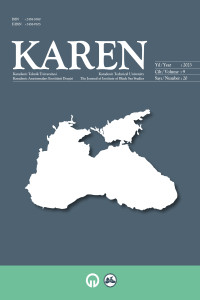BALKANLARDAN ANADOLU’YA KESİK BAŞ TÜRBELERİNİN TÜRK HALK KÜLTÜRÜNDEKİ YERİ
HEAD TOMBS IN TURKISH FOLK CULTURE FROM THE BALKANS TO ANATOLIA
Author(s): Hilmi Savur, Rabia Gökcen KayabaşıSubject(s): Customs / Folklore, Cultural Anthropology / Ethnology, Culture and social structure , Sociology of Culture
Published by: Karadeniz Teknik Üniversitesi - Karadeniz Araştırmaları Enstitüsü
Keywords: Folklore; Tomb; Cut Head; Motif;
Summary/Abstract: The Balkans, which remained under the influence of the Ottoman Empire for 5 centuries, is one of the important research areas of Turkish folk culture. With the conquest of the Gallipoli peninsula by Orhan Gazi’s son Süleyman Pasha in 1354, the Ottoman Empire’s dominance and subsequent conquests in the Balkan geography began. In the Ottoman Empire, the Balkans is called the Rumelia province. The Balkans is an important transit route and settlement area that includes Bulgaria, Greece, Croatia, Serbia, Bosnia and Herzegovina, Macedonia, Albania, Romania, Montenegro and Kosovo, along with a part of Turkey. The Balkans, which was under the domination of the Ottoman Empire for about 5 centuries, is one of the important lands that can be considered as the legacy of the empire. The Ottomans influenced and transformed the Balkans in almost every area during its rule. After the conquest process, a common Turkish folk culture emerged with various interactions between Turks and Balkan peoples who settled in the region. The cut head motif is one of the reflections of the “Alp-Gazi Type”. It is possible to see the "cut head" motif in various genres in Anatolian and Balkans Turkish folklore. It is rumored that the Alp-eren, who moved to the region for the Turkification of Anatolia and the Balkans and the spread of Islam, continued the war by getting their heads cut off by the enemy during the war. In this study, the saints existing in Anatolia and the Balkans were scanned and the saints and endowments with the cut head motif were determined. In the text, the legends and narrations of the saints with this cut head motif are also conveyed. Tombs were identified in the cities of Adana, Niğde, Ankara, Hatay, Erzurum, Isparta, Sinop, Elazığ, Konyai Kars, Muğla, Gümülcine (Greece), Mitrovica (Kosova), Prizren (Kosovo), İskaça (Romania), Adakale (Romania), Şumnu (Bulgaria) and Vranya (Macedonia) and tried to be explained in detail in the study. In the study, two field-oriented literature searches were made and besides, the findings obtained from the field study were tried to be conveyed.
Journal: Karadeniz Araştırmaları Enstitüsü Dergisi
- Issue Year: 9/2023
- Issue No: 20
- Page Range: 573-583
- Page Count: 11
- Language: Turkish

